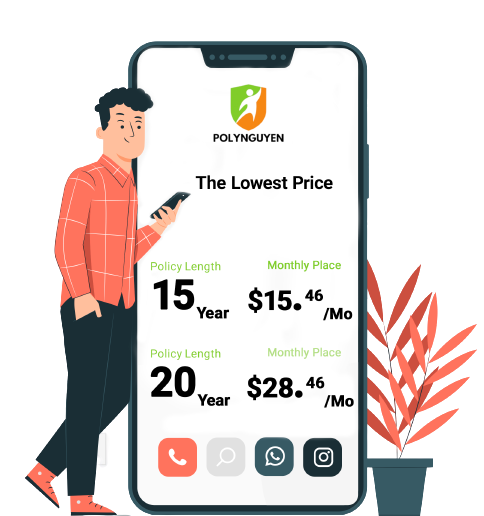How to get car insurance in 5 easy steps
We don't sell your information to third parties.
We’ve saved shoppers an average of$435per year on auto insurance.


How to get car insurance in 5 easy steps
You can get car insurance directly from an insurance company, by talking to an agent, or through an independent online insurance marketplace like Polynguyen.
No matter how you choose to get car insurance, start by gathering information you’ll need, including the social security numbers of all the drivers in your household, your driver’s license number, and details about your car. Then:
How to buy car insurance in five steps
Figure out how much auto coverage you need
Fill out an application
Compare auto insurance quotes
Pick a car insurance company and get insured
Cancel your old car insurance policy
While there are a few ways to get car insurance, the best and most efficient way to get covered in 2022 is by comparing quotes from multiple companies online. That way you can quickly find the most affordable rates in your area for the coverage you need.
1. Figure out how much auto coverage you need
Figuring out how much coverage you need is one of the most important parts of buying auto insurance. In 2020 the medical costs from fatal motor vehicle accidents totaled more than $537 million [1] This financial cost is why it’s so important to be sure you’re fully insured in the event of an accident.
Generally, it’s a good idea for drivers to get as much liability coverage as they can afford. Adding comprehensive and collision coverage is a good idea, but the amount of insurance you should get depends on your car’s value, too. A typical full-coverage policy includes:
Liability coverage: Covers the costs if you cause an accident, including when you damage someone else’s property with your car. Liability insurance is required in most states, and it’s divided into two parts: Bodily injury liability (BIL) and property damage liability (PDL)
Personal injury protection: Covers medical and rehabilitation expenses if you or your passengers are injured in a car accident. Also covers other related expenses, like lost wages
Uninsured/underinsured motorist coverage: Covers the costs if you’re in an accident caused by a driver who either doesn’t have insurance or whose insurance can’t pay for the full extent of the damage
Collision coverage: Covers damage to your own vehicle after an accident, regardless of who was at fault
Comprehensive coverage: Covers any damage to your car that can happen when it isn’t being driven, including damage from extreme weather, falling objects, flood, fire, vandalism, and theft
Gap insurance: If your car is totaled, this pays out the difference between the car’s actual cash value (ACV), which includes depreciation, and the amount you still owe on a car loan or lease so you aren’t stuck making payments on a car you no longer have
Genius tip
We recommend drivers have at least $100,000 per person/$300,000 per accident in bodily injury liability and $100,000 in property damage liability coverage in order to be fully protected. Comprehensive and collision coverage are optional, but they can be valuable protection for your car.
2. Fill out an application
Whether you’re buying car insurance for the first or renewing your coverage with the same insurer, you’ll need the following information on hand:
Names, birthdays and driver’s license numbers for all drivers in the household
Social Security numbers for all drivers in the household
VINs (Vehicle Information Numbers) or make and model years for all vehicles
An address for the insured (where you live and where the car is garaged, which is usually the same place)
Your declarations page from your most recent prior car insurance policy, if you have it
As you go through the application process, your answers to certain questions may earn you discounts on your coverage, like whether you have any accidents or violations on your record, whether you’re a full time student, and if your car is equipped with features like an anti-theft device or GPS tracker.
You’ll also set your coverage amounts — called limits — when you apply for insurance. It’s generally a good idea to have higher coverage limits, even though adding more coverage will affect how much you pay for car insurance. You’ll also have to choose deductible amounts for your comprehensive and collision coverage.
When you get a quote online or use a car insurance calculator, some optional types of coverage may automatically be included that you don’t actually want or need. For example, if you’re a member of AAA and you already have roadside assistance, you don’t need to pay extra to add it to your car insurance policy.
As you shop for insurance, be sure to look carefully at whether there are any add-ons you can remove.
3. Compare auto insurance quotes
It’s a good idea to get quotes from a few different insurance companies before you choose a policy. You should also have an idea of how much you can afford to pay for coverage before you start shopping.
You should look for the insurance company that offers you the most protection and the best customer service at the lowest rates.
Not sure which company to go with? Use our compare car insurance page or our list of the best car insurance companies to learn more about your options before you pick a policy.
Genius tip
Setting a higher comprehensive or collision deductible leads to lower premiums, because you’re agreeing to pay more out of pocket in the event that you file a claim on your comp or collision insurance.
What are the different ways to shop for car insurance?
There are a few ways that you can shop for car insurance. Depending on your preference, you could buy a policy directly from an insurance company, work with an agent, or get car insurance from a broker.
Each of these methods for getting insured has its own pros and cons that you should consider. Your own insurance history, knowledge, and preferences will impact your choice.
Method
Pros
Cons
Buy directly from an insurance company
Many companies make it simple to get quotes and buy coverage online
You’ll only see quotes from one company at a time, so you’ll have to compare costs yourself to find the cheapest rate
Buy through an agent
Agents have physical offices in your area so you can buy insurance in in person
Some agents may charge additional fees or only show you quotes from certain companies
Shop through an online marketplace
You’ll be able to compare quotes from multiple companies at once, without having to enter your information again and again
You won’t be able to visit an office in person, so this option is best for people who like shopping online or over the phone
4. Choose a policy and get insured
Once you’ve compared your quotes and picked an insurance company that you feel good about, it’s time to get covered.
When you buy a car insurance policy, you’ll set a start date for when your policy will start, and you’ll pay your first premium.
You’ll typically receive proof of coverage and some sort of welcome package from your insurer, with information about how to access your account and where to see your ID cards or declarations page.
5. Cancel your old car insurance policy
If you’ve been shopping for car insurance to replace a current policy, wait until after your new coverage is in place before you cancel your old policy. You want to make sure you don’t leave any gaps in your coverage.
To do this, set the cancellation date of your old policy and the effective date of your new policy on the same day. Insurance policies begin and end at 12:01 AM on a given date, so you don’t have to worry about having a full day of overlapping insurance.
